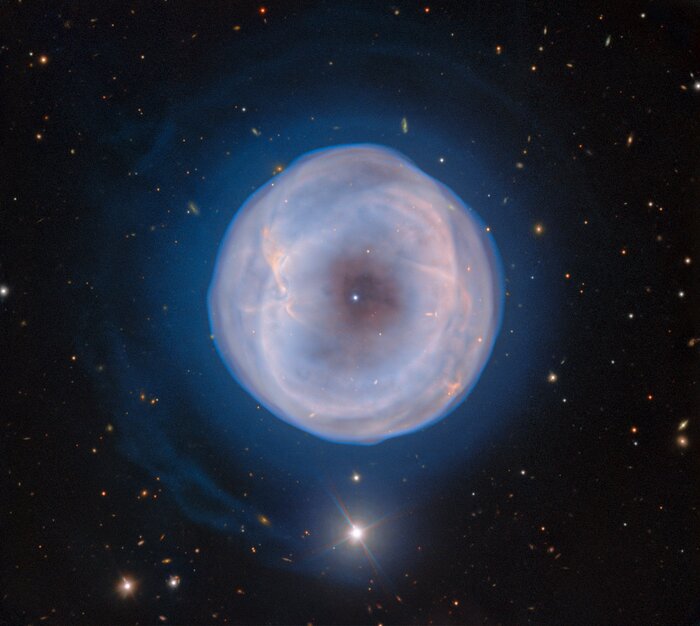Blooming of the Spare Tyre Nebula
IC 5148, nicknamed the Spare Tyre Nebula, is a beautiful planetary nebula located about 3000 light-years away near the ‘neck’ of the southern constellation Grus (The Crane). This image, captured with the Gemini South telescope, one half of the International Gemini Observatory operated by NSF’s NOIRLab, showcases the looming cloud of gas of IC 1548 and the central stellar remnant from which the gas radiates. It’s one of the fastest expanding planetary nebulae, pushing out into space at 180,000 kilometers per hour (112,000 miles per hour).
With small telescopes, this nebula looks like a bright central star with an outer ring. The mesmerizing layers of gas are faint. They are almost undetectable without the use of larger telescopes, and not with the clarity captured in this image using the Gemini Multi-Object Spectrograph (GMOS) on Gemini South. Around the time IC 5148 was discovered by astronomers in 1894, researchers coined the term planetary nebula to refer to these giant gaseous balls that looked like giant planets. Today we know that these balls are in fact stellar remnants.
At the center of IC 5148 is a white dwarf, the hot core of the dying star, surrounded by asymmetrical gaseous ‘blooms’ and a faint halo ring. The predecessor of the white dwarf was likely a star of a similar mass to our Sun. At the end of that star’s life, the internal pressure imbalance resulted in the star swelling up into a red giant. As it grew, the outer layers of the gas and stellar material were pushed into space to form the nebula we see today. The central hole — the dark patch surrounding the star — is due to the pressure of the radiation from the star that pushes the surrounding gas away from the core and leaves a vacant space. The formation of the ring and the bow-like structures of gas are marks of the evolutionary history of IC 5148 — but the mechanisms that created them remain a mystery to astronomers.
Credit:International Gemini Observatory/NOIRLab/NSF/AURA
Image processing: T.A. Rector (University of Alaska Anchorage/NSF NOIRLab), J. Miller (Gemini Observatory/NSF NOIRLab), M. Rodriguez (Gemini Observatory/NSF NOIRLab), & M. Zamani (NSF NOIRLab)
About the Image
| Id: | iotw2344a |
| Type: | Observation |
| Release date: | Nov. 1, 2023, noon |
| Size: | 2063 x 1845 px |
About the Object
| Name: | IC 5148 |
| Distance: | 3000 light years |
| Constellation: | Grus |
| Category: | Nebulae |
Wallpapers
Coordinates
| Position (RA): | 21 59 35.20 |
| Position (Dec): | -39° 23' 14.85" |
| Field of view: | 5.51 x 4.93 arcminutes |
| Orientation: | North is 14.9° right of vertical |
Colors & filters
| Band | Wave-length | Tele-scope |
|---|---|---|
| Optical g | 475 nm | Gemini South GMOS-S |
| Optical OIII | 499 nm | Gemini South GMOS-S |
| Optical r | 630 nm | Gemini South GMOS-S |
| Optical H-alpha | 656 nm | Gemini South GMOS-S |
| Optical i | 780 nm | Gemini South GMOS-S |

